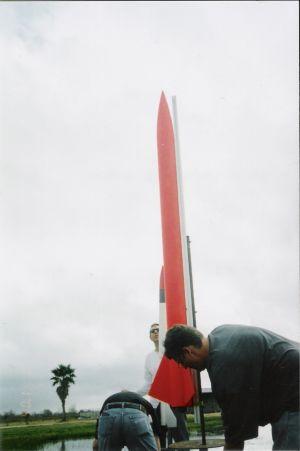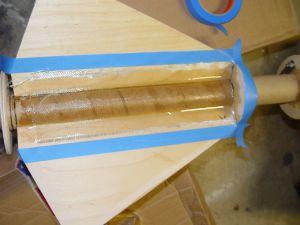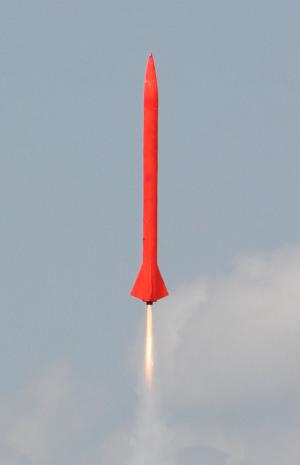| Construction Rating: | starstarstarstarstar_border |
| Flight Rating: | starstarstarstarstar |
| Overall Rating: | starstarstarstarstar_border |
| Manufacturer: | LOC/Precision  |

Brief:
This is a large single staged rocket by LOC Precision (Stock #PK-77) which has
a 54mm motor tube which is designed to fly on I, J and K motors. I selected
this rocket to do my Tripoli L2 Certification flight with. I ordered it from
Quickburst.Net in October 2004 and had it in a few days.
Construction:
The components included with the kit were of overall fine quality as can be
expected from LOC. The kit came in a large box and contained:
- 1 Main 54mm Motor Mount Tube
- 1 Parachute - 60" Rip Stop Nylon
- 1 Payload Airframe Section 17" x 5.5"
- 1 Plywood Bulkhead Plate Assembly
- 1 Fin Set
- 1 Main Airframe 34" x 5.5"
- 1 Shock Cord Mount Centering Ring
- 2 Launch Lugs
- 1 Shock Cord (Tubular Nylon)
- 2 Main Centering Rings
- 1 Fin Guide
- 1 Plastic Nose Cone (5.5" R.W.W.)
- 1 Shock Cord Mount Hardware Set (Eye-Bolts)
- 1 PK-77 Color 8.5" Insert & Instructions
Modifications:
This kit was enjoyable to build and it was (and still is) my largest rocket
ever. I made a good number of modifications to this rocket so it's not exactly
stock by any means. It's name is the "Bigger Big Nuke". Here are the
ways that I enhanced this rocket:
1) I added an extra 24" x 5.5" LOC Airframe and coupler to the main airframe to stretch the rocket by a few feet. This was to add stability by moving the CG further forward from the CP in order to allow for a heavier than normal build. So instead of standing at 6 feet tall by kit design, this craft stands at 8 foot 5 inches tall.
2) I discarded the entire recovery system that came with the rocket including the fore of three motor mount centering rings that LOC calls the "Shock Cord Mount Centering Ring". Expecting a heavier than stock build I designed my own recovery system.
To begin with I replaced the stock non-forged eye-bolts that came with the kit, with 1/4" Stainless Steel U-Bolts from Lowes hardware. They are considerably more expensive (cost ratio of about 20x) than the eye-bolts that came with the kit, however in my opinion they are worth the expense as insurance. An eye-bolt that is not forged in one piece, or later welded shut, will over time start to stretch out and will eventually fail. Thanks to Chad Ellis and Jon Ruehle for help with that research.
Next I replaced the fore of three motor mount centering rings that LOC calls the "Shock Cord Mount Centering Ring". It had a single 1/4" hole drilled in it in order to seat the included eye-bolt. Since a U-Bolt requires two 1/4" holes instead of drilling another in what was included I ordered some rings from Quickburst.Net and drilled one of them out with two 1/4" holes. I was able to move the U-Bolt out just a little more away from the top of the motor tube that way, thus allowing for a motor longer than the tube itself to slide up past the base mount and quicklink.
I discarded the tubular nylon that came with the kit due to the fact that tubular nylon is not fire resistant and it will fail over time. It will fail when a section has been charred by ejection and snap in half at that point on a later flight, or it can even fail with no prior damage when coming into direct contact with an ejection charge. Well, since the recovery harness / shock cord will frequently encounter ejection charges (like every time you fly the rocket), I selected Kevlar®. Using stainless steel quick links (also from Lowes, also expensive but the strongest there are), I attached a 35 foot section of 2" Kevlar® strap. It is sold by Giant Leap in Louisiana and www.the-motorman.com in Houston. Once again this is very expensive material as this strap alone was over $50. But I think it's the safest way to go when thinking about the weight you are launching. I then added another 40 feet of Tubular Kevlar® (a little cheaper than the strap material and has some minimal shock absorbance.)
Finally I selected a nice strong 72" TAC-1 parachute.
3) The most difficult part of this build was cutting out the fin slots. I was under the impression that the kit came with the fin slots already cut, yet the slots that were in the main airframe were only about 3" long where the base of the fins is 15.5". Also they were about half the thickness of the fins, thus only useful as a guide. I started out using an Exacto knife and worked for many hours just on the first slot. Finally I purchased a Dremel cutter to finish the job. Always use safety glasses with Dremel cutters or any power tool. When finishing the last slot I broke about 6 cutting disks. When they come apart (they are designed to break) they become projectiles. Well over 90% of the work on building this rocket went into just cutting the fin slots.
I built the fin can outside the rocket by cutting the fin slots all the way to the aft end of the airframe. Thanks to Jon Ruehle of Challenger for hosting a "Glass Class' at his shop in Houston, and to Tim Berg for the last minute suggestion, I glassed the fins onto the motor mount. (See Photos) I had first removed the glassine layer from the motor tube to establish prime adhesion.
 The build
was wrapped up with sliding the fin can in one night, adding a touch of
fiberglass to the inside of the airframe at the internal fin roots, some
external epoxy fillets and the bulkhead with SS U-Bolt. I then attached a Giant
Leap 54mm Slimline motor retainer with JB Weld. After about a week of work, a
few hours each night, the rocket was done.
The build
was wrapped up with sliding the fin can in one night, adding a touch of
fiberglass to the inside of the airframe at the internal fin roots, some
external epoxy fillets and the bulkhead with SS U-Bolt. I then attached a Giant
Leap 54mm Slimline motor retainer with JB Weld. After about a week of work, a
few hours each night, the rocket was done.
Finishing:
I coated the entire rocket with about two to three layers of Kilz white
sandable primer. White was selected as it is a good base for a bright neon
fluorescent paint job. As this rocket was designed for a single mission, to get
my Tripoli L2 Certification, which includes being able to see and find the
thing, I used about 4 cans of RustOleum Specialty (#1955) Day-Glo Fluorescent
Red-Orange. This has in fact helped to locate it on multiple occasions (see
photos and flight logs).
 I am going
to rate this rocket at 4.0 of 5.0. If the fin slots were cut to the proper
length and width it would have sliced off about 8 hours and a week of build
time. And while the stock recovery system will work, it just gets by, as it in
my opinion is not to be trusted for repeated flights. Eye-bolts will stretch
out and fail, and tubular nylon will fail over time. I understand that this
type of recovery system is somewhat standard in HPR kits, very likely to keep
costs low, but please do yourself and everyone at your range a huge favor and
upgrade your recovery system if you want to do it right.
I am going
to rate this rocket at 4.0 of 5.0. If the fin slots were cut to the proper
length and width it would have sliced off about 8 hours and a week of build
time. And while the stock recovery system will work, it just gets by, as it in
my opinion is not to be trusted for repeated flights. Eye-bolts will stretch
out and fail, and tubular nylon will fail over time. I understand that this
type of recovery system is somewhat standard in HPR kits, very likely to keep
costs low, but please do yourself and everyone at your range a huge favor and
upgrade your recovery system if you want to do it right.
Also, instead of using the supplied launch lugs, I attached two single body Delrin buttons from railbuttons.com. For the maiden voyage I used the series 1500 5/16" large buttons which required a special rail which my Tripoli Prefect brought. I then installed the standard size series 1000 Delrin's on the other side which I have used since. They fit most all rails.
Construction Rating: 4 out of 5
 Flight:
Flight:
The five flights to date have been really nice. My L2 Cert flight was delayed
due to weather a few times, which only added to the anxiety. The first flight
was planned for November 20th, 2004 at the Hearne Texas Municipal Airport
during the annual Crossroads of Texas Rocketry Festival sponsored by the
Northwest Houston Rocketry Association and the NASA Houston Rocket Club. Cloud
cover prevented the flight due to Tripoli regulations. And then came the rain
and lightning storm.
The second attempt was to be the following weekend at the Hippodrome in Hutto Texas at a launch sponsored by the Austin Area Rocketry Group. That launch was scrubbed at about 9pm the night before due to a large amount of rain.
Finally a launch window opened up on none other than January 1st, 2005. What a way to start the new year! On 1/1/5 I launched this rocket at Alpha Ranch in Waller County Texas on a Cesaroni Pro54 J-380 Smokey Sam with a manually set 6 second ProDat54 bored delay.
Upon arriving at the launch site I was glad to see rocketry friends Chad Ellis, Chase Hrncir and Mike Williams (L3) early that morning.
 Perhaps due to the
several months of delays due to weather I was on the nervous side. After all,
you can only do your first L2 attempt once, and I wanted it to work perfect. It
did. Apogee ejection was perfect (I added another 2 grams of BP to the stock
CTI Pro54 J380 ejection charge), and thanks to winds gusting up to 20 mph, it
was a long walk. Well over a mile, but I found it safe and sound in a cow
pasture not too far from a small lake. No damage at all. I sat for a breather
on the shore of that little lake which when I first saw it, I feared the rocket
may have landed in it. It had landed about 200 feet to the north of it. I was
so far from the ranch that it launched from that the houses could barely been
seen in the distance. Carrying the thing back over my shoulder took well over
an hour and I was surprised at how much more work it is to haul such a heavy
rocket back.
Perhaps due to the
several months of delays due to weather I was on the nervous side. After all,
you can only do your first L2 attempt once, and I wanted it to work perfect. It
did. Apogee ejection was perfect (I added another 2 grams of BP to the stock
CTI Pro54 J380 ejection charge), and thanks to winds gusting up to 20 mph, it
was a long walk. Well over a mile, but I found it safe and sound in a cow
pasture not too far from a small lake. No damage at all. I sat for a breather
on the shore of that little lake which when I first saw it, I feared the rocket
may have landed in it. It had landed about 200 feet to the north of it. I was
so far from the ranch that it launched from that the houses could barely been
seen in the distance. Carrying the thing back over my shoulder took well over
an hour and I was surprised at how much more work it is to haul such a heavy
rocket back.
I certified Tripoli Level 2 on 1/1/5 in the book for TRA Section #002, (the first Tripoli section in Texas, second in the world) with the signature of Mr. Dan DeHart, my Tripoli Prefect.
The second flight was a week later on January 8th 2005 at the Hearne Texas Airport. I repeated the L2 flight on another CTI Pro54 J380-6. Winds were real low that day so I selected my first K motor for the third flight, the largest Cesaroni motor there is that has motor ejection, a CTI Pro54 K650SS. That was beautiful. Landed in the field even with apogee deployment of main as I had never used electronics before. I estimate the flight at 5000-5500 feet perhaps my first mile high flight. Wish I had had a computer onboard to log that.
 Fourth
flight was 6-11-5 again at Hearne. Selected a nice long 4.1 second burn CTI
Pro54 J295 and set the delay at 10. Perfect, landed in the field.
Fourth
flight was 6-11-5 again at Hearne. Selected a nice long 4.1 second burn CTI
Pro54 J295 and set the delay at 10. Perfect, landed in the field.
Fifth flight was 8-13-5 again at Hearne and again on a nice long 4.1 second burn J295-10. Apogee perfect landed in the field.
Recovery:
Flight recovery has been as well as can be expected for a single, apogee motor
deploy high powered rocket that has only been flown on J's and a K.
Flight Rating: 5 out of 5
Summary:
I am very pleased with this rocket, in fact so pleased that today I ordered a
75mm version with an electronics bay, called the LOC Big Nuke 3E. Mine will be
called the "Even Bigger Big Nuke" and I added another 40"
airframe to stretch it up to about 11 feet in height. With the use of
electronics and dual deployment, frequent K and L range flights should be
normal.
Thanks to the Houston Area Rocket Clubs for the help with my L2.
Overall Rating: 4 out of 5
 |
 |
Flights
Sponsored Ads
 |
 |











